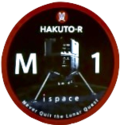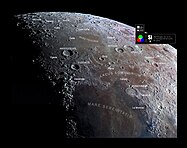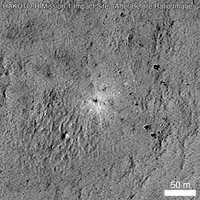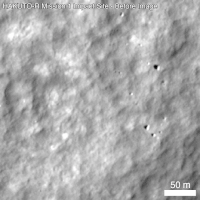Hakuto-R Mission 1
 Full-size model of Hakuto-R | |
| Mission type | Technology demonstration |
|---|---|
| Operator | ispace |
| COSPAR ID | 2022-168A |
| SATCATno. | 54696 |
| Website | ispace-inc |
| Spacecraft properties | |
| Spacecraft | Hakuto-R M1 |
| Spacecraft type | Lunar lander |
| Manufacturer | ispace |
| Launch mass | 1,000 kg (2,200 lb) |
| Dry mass | 340 kg (750 lb) |
| Start of mission | |
| Launch date | 11 December 2022, 07:38UTC |
| Rocket | Falcon 9B1073.5 |
| Launch site | CCSFS,SLC-40 |
| Contractor | SpaceX |
| End of mission | |
| Last contact | 25 April 2023, 16:40 UTC |
| Moonlander | |
| Landing site | Atlas crater(attempted).47°34′52″N44°05′38″E/ 47.581°N 44.094°E |
 Hakuto-R Mission 1 patch | |
Hakuto-R Mission 1was a failedprivateJapanese uncrewedlunar landingmission built and operated byispace,which was launched in December 2022 for an attempted lunar landing in April 2023.
This first Hakuto mission was primarily a technology demonstrator and carried theEmirates Lunar Mission.[1]Travelling approximately 1,400,000 kilometres (870,000 mi), it is the furthest a privately-funded spacecraft has traveled.[2]Communication with the lander was lost during the final seconds of its April 2023 descent.[3]
Background[edit]
The project began with engineer Andrew Barton in 2008, who sought to win theGoogle Lunar X Prizeby landing a privately-funded rover on the Moon, and gathered an international group of professionals to createWhite Label Space.[3]Takeshi Hakamada would foundispacein 2010 as a Japanese branch of White Label Space.[3]Many of the professionals abandoned the project by 2013, though a group of Japanese members sought to continue with the project, which was renamed from White Label Space toHakuto,based on the whiteHare of InabainJapanese mythology.[3][4]By 2017, ispace had secured $90 million in funding and though no teams in the Google Lunar X Prize ever launched before the 2018 deadline, the Hakuto team would continue.[3]In April 2022, iSpace was placed on theTokyo Stock Exchange,receiving a 65% increase in itsshare pricewithin two weeks.[3]
Lander specifications[edit]
The Hakuto-R lander was measured at 2.3 metres (7.5 ft) tall by 2.6 metres (8.5 ft) wide, with a total weight of approximately 1,000 kilograms (2,200 lb) with its payload and fuel.[5]To perform a stable landing, the lander was equipped with fourlanding legsand a mainthruster.[5]
Mission[edit]

Hakuto-RMission 1 was launched on 11 December 2022 aboard aFalcon 9rocket,[6]separating from the rocket 47 minutes later at a distance around 970 kilometres (600 mi) away from Earth.[3]Inside the spacecraft were payloads from theEmirates Lunar MissionroverRashidin a partnership with theMohammed bin Rashid Space Centre(MBRSC), along withTomyandJAXA'sSora-Qtransformable lunar robot.[2][7][8]The lander also housed another payload, a music disc featuring the song ‘SORATO’ by the Japanese rock bandSakanaction,which was initially released in 2018 as a part of the Team Hakuto campaign for the Google Lunar X Prize.[9]
Using data collected from a previous lunar scanning mission, ispace determined that the mission would attempt a landing in theAtlascrater in theMare Frigorisregion of the Moon; three other backup locations were selected, like those inLacus Somniorum,Sinus IridumandOceanus Procellarum,among others.[5][10]In an effort to conserve fuel, the mission used a slower path to approach the Moon, enteringlunar orbitin March 2023.[5]
Landing attempt[edit]
After a five-month travel time, the mission traveled 1,400,000 kilometres (870,000 mi), further than any privately-funded spacecraft, to attempt alunar landingon 25 April 2023.[2][11]
During the official live-stream,[12]among the four possible landing locations, the site inLacus Somniorumwas initially shown in the animation, saying it was based on real-time telemetry from the lander; that later turned out to be misleading, since the telemetry coming from the lander was not reliable, and the actual attempted landing site was nearAtlas crater,as had been decided initially.[13][14][15]
Communication with the lander was lost during the final moments of descent to the lunar surface at 16:40 UTC (00:40 JST) on 25 April.[3]Analysis determined that the lander plummeted uncontrollably when the propellant was exhausted. This happened because the onboard computer wrongly assumed the radar altimeter was faulty, and ignoring its data, misjudged the actual altitude of the spacecraft and kept hovering 5km above the surface of the Moon.[3][16][17][18]
The crash site was later identified by theNASALunar Reconnaissance Orbiterteam.[13]
See also[edit]
- List of missions to the Moon
- Lunar Flashlight(launched as a rideshare)
References[edit]
- ^"NASA – NSSDCA – Spacecraft – Details".nssdc.gsfc.nasa.gov.Retrieved2023-04-25.
- ^abcAlamalhodaei, Aria (25 April 2023)."Watch ispace attempt to land on the moon for the first time".TechCrunch.
- ^abcdefghiChang, Kenneth (2023-04-25)."Live Updates: A Japanese Company Attempts the 1st Private Moon Landing".The New York Times.ISSN0362-4331.Retrieved2023-04-25.
- ^The Japanese Space Bots That Could Build Moon ValleySarah Scoles,Wired14 May 2018
- ^abcd"Watch Japan's ispace attempt moon landing with Hakuto-R lunar lander".New Scientist.25 April 2023.Retrieved2023-04-25.
- ^Swift, Rocky (13 April 2023)."Japan's ispace launches commercial moon lander, in potential world first".Reuters.
- ^Rabie, Passant (12 December 2022)."SpaceX Launches Moon-Bound Private Japanese Lander Following Delays".Gizmodo.Retrieved15 December2022.
- ^"ispace, 2022 năm mạt khoảnh の đánh ち thượng げに hướng け, フライトモデル tổ み lập て の cuối cùng công trình に xuống tay Hakuto-R の ミッション1と2 の tiến 捗 báo cáo を thật thi".ispace.Retrieved2023-04-29.
- ^"Ispace Announces Mission 1 Launch Date".
- ^"ispace Announces Mission 1 Launch Date".ispace.Retrieved2023-04-27.
- ^"A private moon lander will make history when it touches down on April 25. Here's how to watch it live".Space.24 April 2023.
- ^ispace Hakuto-R Mission 1: Landing Live Stream,25 April 2023,retrieved2023-04-27
- ^abcSpeyerer, Emerson (May 23, 2023)."Impact Site of the Hakuto-R Mission 1 Lunar Lander".lroc.sese.asu.edu.Retrieved2023-05-23.
- ^"2022 năm, nguyệt の ánh giống データはこ の nơi にやってくる. Dân gian nguyệt mặt thăm tra プログラム “Hakuto-R” Mission Control Centerを mở ".ispace.Retrieved2023-04-27.
- ^"ispace Announces Mission 1 Launch Date".ispace.Retrieved2023-04-27.
- ^"Status Update on ispace Hakuto-R Mission 1 Lunar Lander".ispace.Retrieved2023-04-26.
- ^"Japan Spacecraft Believed to Have Crashed on Moon During Landing".Bloomberg.2023-04-25.Retrieved2023-04-27.
- ^Nhật Bản truyền hiệp hội."Nguyệt mặt chạm đất khai phát の dân gian xí nghiệp が hội kiến" trên đường で nhiên liệu がつきて rơi xuống か "".NHKニュース.Retrieved2023-04-27.



